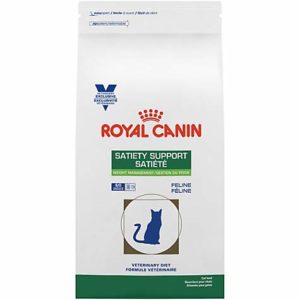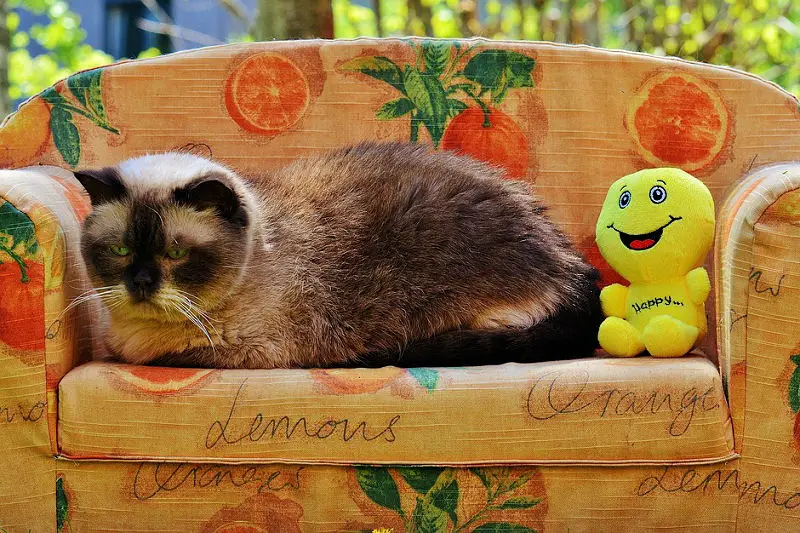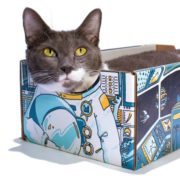Did you know that an overweight cat is at significantly higher risk for many health issues and a shorter life? Excess weight can reduce their overall quality of life by interfering with the normal activities they used to enjoy when they were more physically fit.
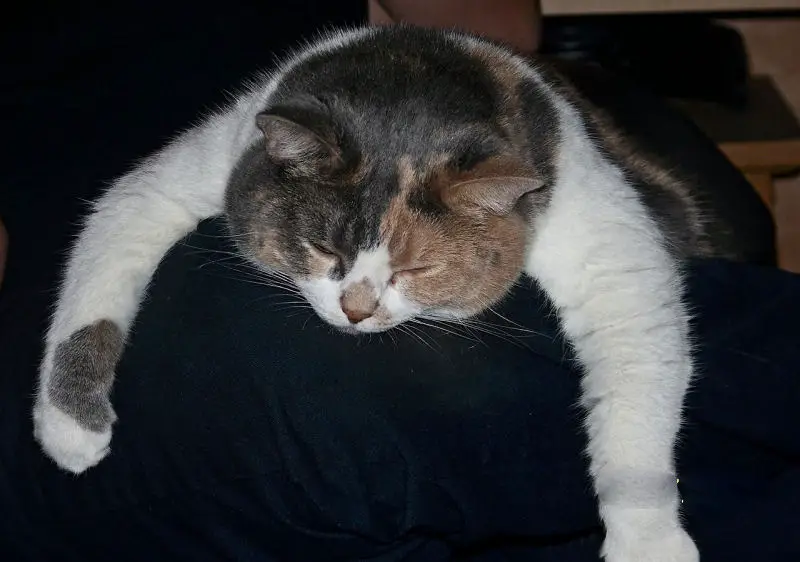
Overweight cat health problems are becoming more numerous and more serious. When it comes to keeping cats at a healthy weight, humans contribute to both the problem and the solution.
The Human Element
Just as people need to control the temptation to overindulge, cat owners need to control the temptation to overindulge their pets.
A survey of pet owners by Royal Canin in 2018 revealed that more than half of cat and dog owners always or often give their pets food if they beg for it, and almost a quarter of them overfeed their pets to keep them happy. I think we’re all guilty of doing this at times.
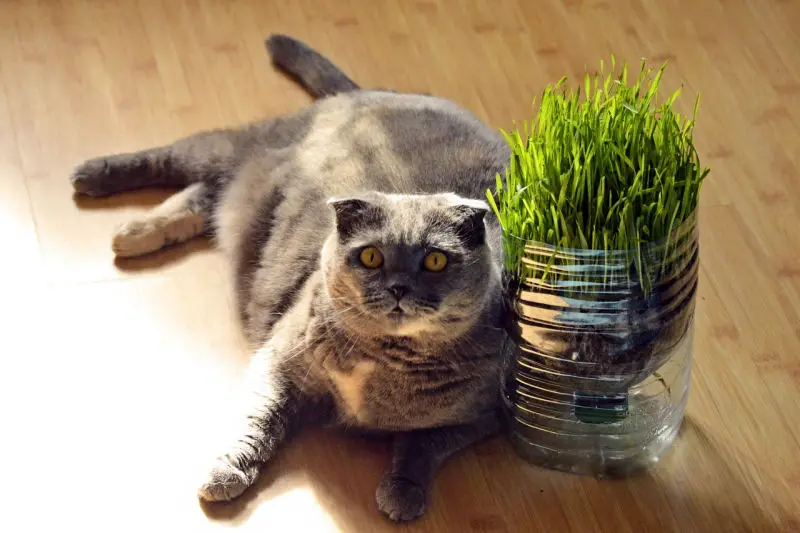
Fat Facts:
- According to the Association for Pet Obesity Prevention, 59% of American cats are estimated to be obese
- 15% of cat owners said their pet’s weight was normal when it was actually overweight or obese
- The five states that rank highest for obese cats are Minnesota, Nebraska, Iowa, Idaho, and Delaware
You will never find an overweight cat in the wild. They just don’t exist. So the weight problem is due to domestication. This limits the problems to diet, the medical system used and the environment of the cat.
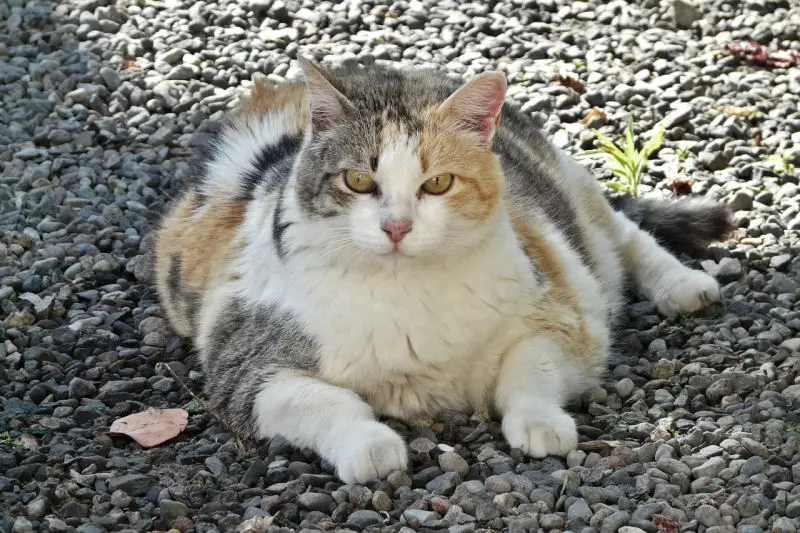
Why a Healthy Weight is Important for your Cat
According to the Association for Pet Obesity Prevention (APOP), as little as two pounds above your cat’s ideal weight can put it at risk for developing some serious medical conditions. Unfortunately, when a cat is overweight or obese it no longer is a question of ‘if’ your cat will develop a condition secondary to the excess weight but ‘how many and how soon! ‘
Some of the common disorders associated with excess weight on your cat include:
- Type 2 diabetes – an obese cat is at least 3 times more likely to develop than serious disease as a cat of normal weight
- Kidney disease
- Chronic inflammation
- Heart disease
- Osteoarthritis
- High blood pressure
- Many forms of cancer – especially intra-abdominal cancers
Overweight and obese cats are much more likely to live shorter lives than their fitter, normal weight counterparts. Heavy cats tend to physically interact less with their families and are less energetic and playful. Because they tend to lay around more, it is easy to overlook illnesses since we attribute their lethargy to their “normal laziness.”
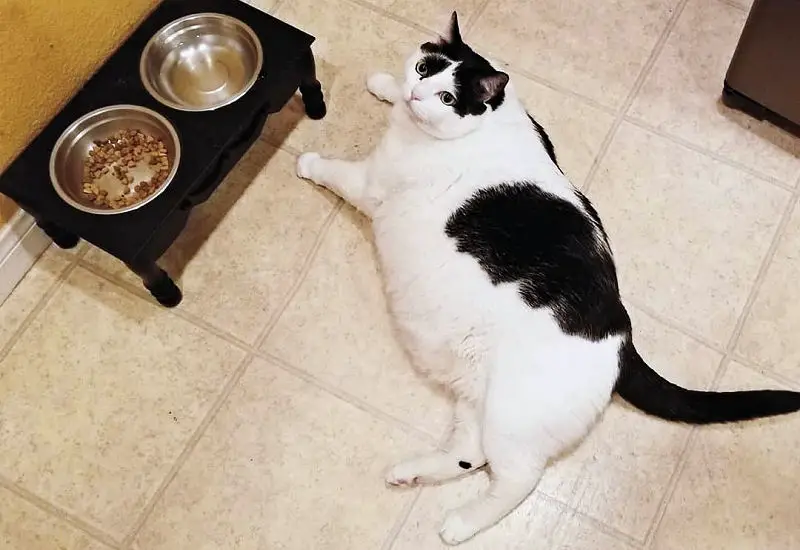
Above photo is our IG pal Carl from @treats4me619
Why So Many Cats Are Overweight
Four of the most common reasons that cats are packing on the pounds are:
- They’re on the wrong diet
- They’re being overfed
- Getting too many treats
- Getting too little exercise
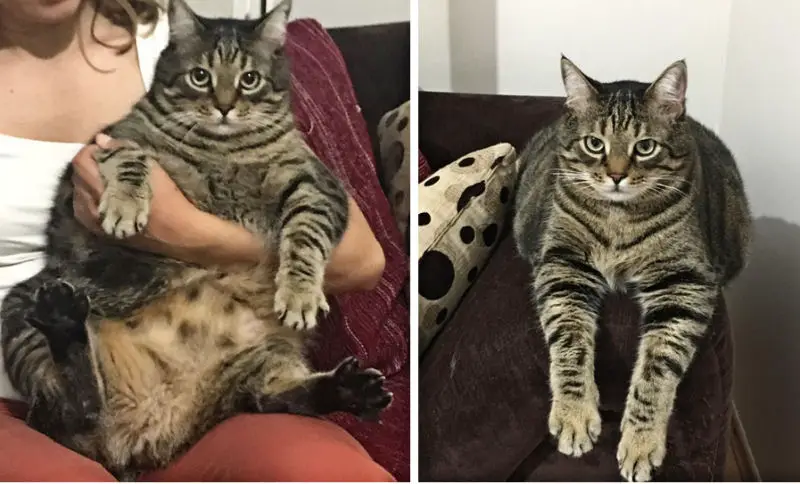
Above photo is our IG pal Ugur from @ugurkedisi
Is My Cat Overweight?
If you are unsure whether your cat is overweight to an unhealthy degree, consider the following:
- Does your cat have trouble, running, climbing and jumping?
- When viewed from above, do his, or her, sides bulge?
- When you look at him, or her, sideways, does the belly hang down?
- Is there a large layer of fat covering the ribs? You should be able to feel your cat’s ribs but you should not be able to see them.
- Is your cat sedentary? Does he, or she, spend all day sitting or laying?
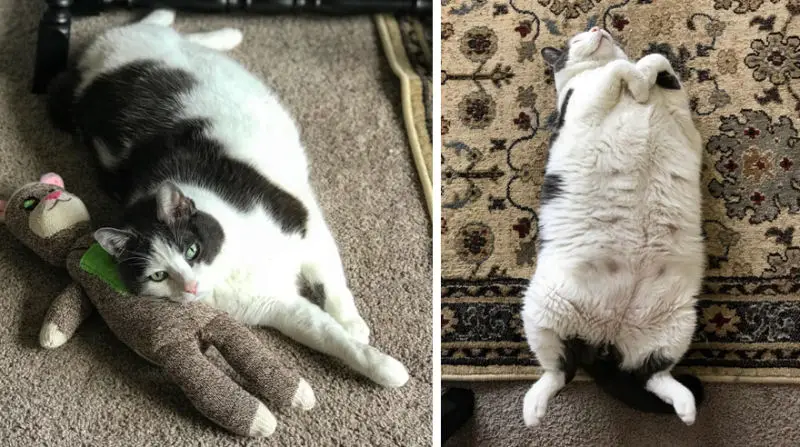
Above photo is our IG pal The Chief from @the.chief_squeaks
One way to evaluate your cat’s body condition is to view their silhouette from above and from the side. The key structures to look at are the ribs, spine, hip bones, waist, abdomen and muscle mass. At a healthy weight, you should be able to see your kitty’s waistline (an hourglass figure) from above. From the side, your cat’s abdomen should appear tucked up behind the rib cage.
The Body Condition Score visual guideline from WSAVA (below) illustrates:
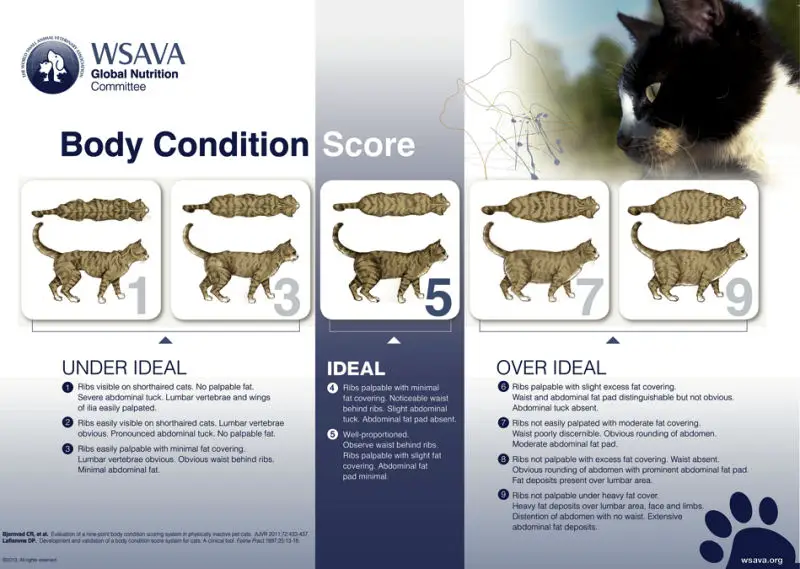
If you feel that your cat may be overweight, please talk to your vet, who will be able to confirm your suspicions, rule out possible health causes, and guide you on the best course of action.
Start with Calories
For weight loss, the formulas seem simple enough: fewer calories in plus more calories out equals weight loss. Unfortunately, it’s not as simple as that. For starters, cats that are overweight or obese must eat. Their physiology is different than humans or dogs and if they do not eat for as little as two consecutive days, they can develop a life-threatening form of liver disease known as hepatic lipidosis. Obese humans starting a diet program are also vulnerable to this serious condition. It is for this reason that you should never put your cat on a diet without the assistance of your veterinary healthcare team.
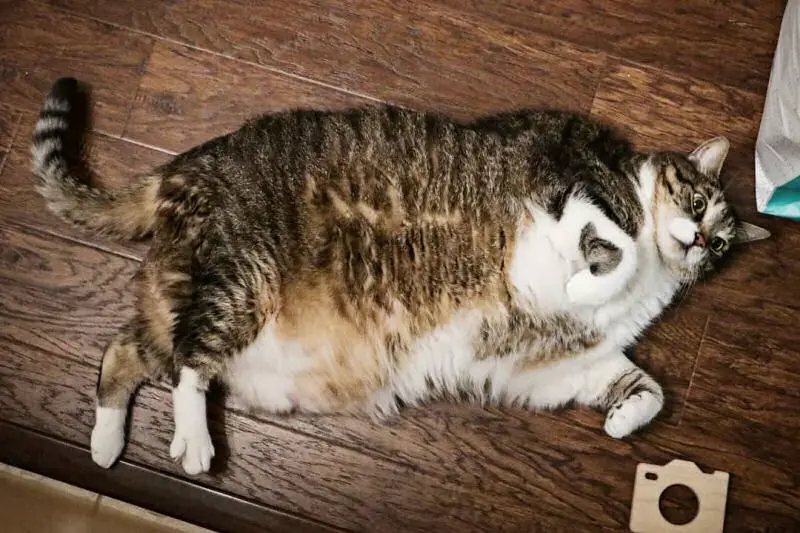
Above and remaining cat photos are of our IG pal Hercules Rockefellar from @fatcathercules
Change Diet Gradually
When you are introducing a new diet to your cat, allow several days for the transition. It is recommended to gradually incorporate the new diet over a one to two week period. Start by substituting one-quarter of the diet for two to three days, then increase to one-half total volume of food for another two to four days, then three-quarter new food for a final three to five days before completely switching to the new diet.
To enhance the palatability of the diet food, try warming the food or adding an omega-3 fatty acid supplement or salmon juice over the food. One of the reasons canned diet foods work better is due to the fact that our finicky felines often prefer wet food over dry.
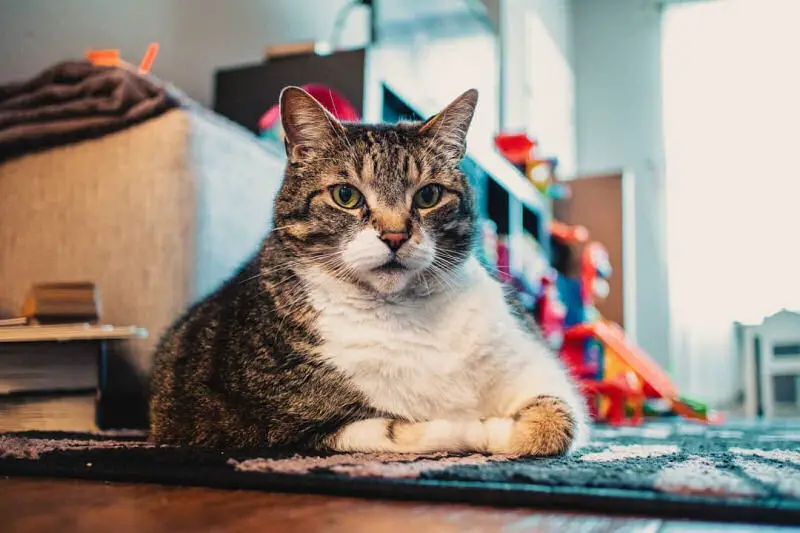
Cat owners consider taste to be the most important factor when buying food for their cats, but science shows that taste is more than just flavor. Great taste is a result of the right nutrient balance, which is affected by satisfying texture, savory aroma, specific kibble size, adapted kibble shape and desirable flavors. Learn more in a post we published last year called Cats Savor More Than Just Flavor.
About 18 months ago we transitioned our cats to a special Royal Canin formula (sensitive digestion) and since then their weight and overall health has been excellent (both we and our vet are very pleased!).
We encourage concerned cat owners to ask their veterinarian for assistance. Of note, Royal Canin just launched a new satiety support diet for cats designed for weight loss. Please note that you will need a medical recommendation from your veterinarian.
Introduce Creative Play
To increase the amount of exercise your cat gets, it’s very important to play with him, or her, more. Wand toys, balls and laser pointers are all popular with cats and will help them to become more active.
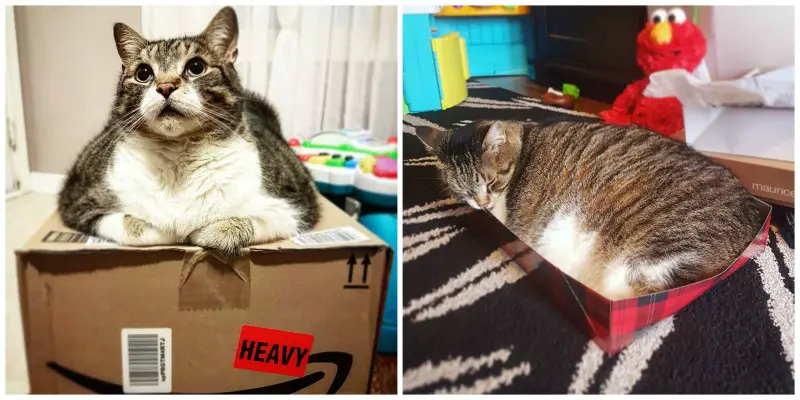
While we may take our dogs out for a brisk walk or jog, our cats aren’t designed to perform that sort of activity well. Our cats prefer the hundred-yard dash to the marathon. Just because cats aren’t good endurance athletes doesn’t mean we shouldn’t encourage them to move.
Some simple tips for getting your cat to move more are:
- Play “Find the Food” Move the food bowl upstairs or downstairs and rotate it so that the cat always has to walk to get to its food bowl. Cats are smart, and if the food bowl moves upstairs, they’ll start relocating upstairs, too.
- Move the food bowl as far away from your cat’s favorite haunts as possible. Again, many cats will sleep and lay near the food bowl so they don’t have to go far when the eatin’ urge hits!
- Use feather toys, flashlights, paper bags or balls, anything that your cat finds interesting to chase. Try to engage your cat for ten minutes twice a day. You can do this while you eat, watch television or even read. There are numerous toys that move and squeak that may also be interesting to your cat. Experiment and understand that what is exciting today may be boring tomorrow.
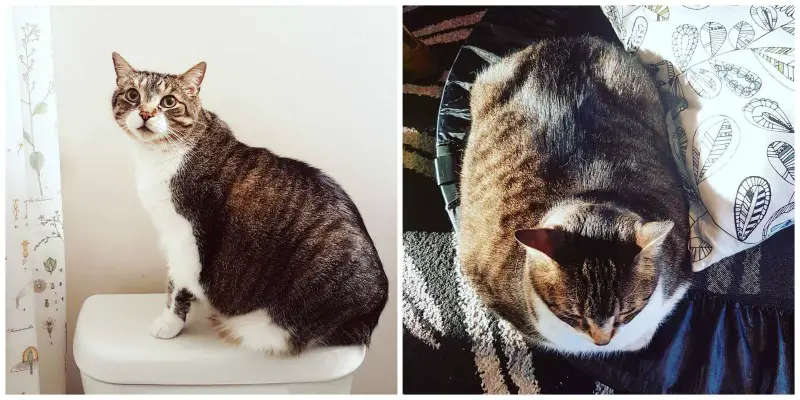
Weigh-Ins and Follow Up
After you’ve put your cat on a weight loss program, it’s critical that you determine if it’s working for your cat. Each cat is an individual and may require many changes in diet or routine before finding the correct approach. In general, your cat should be weighed every month until the ideal weight is achieved. If there is no significant weight loss in one month, typically about one pound, then a new approach should be pursued.
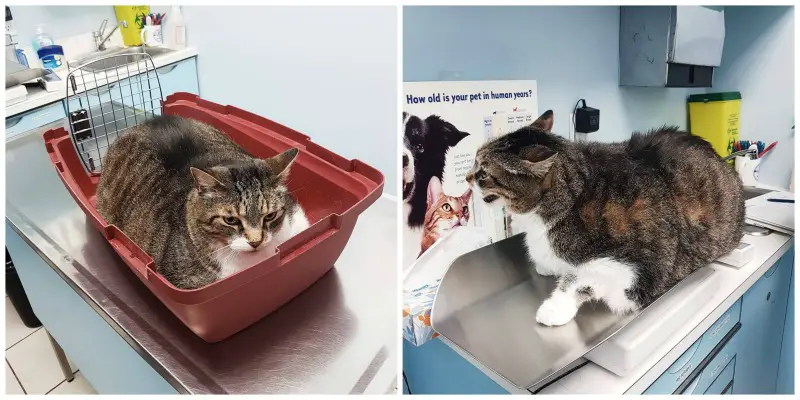
There is nothing more frustrating than persisting in a behavior pattern that is not achieving the results we desire when a slight change could deliver significant improvements. Work closely and actively with your veterinary healthcare team to reach your goals faster and more safely. Here’s to helping your kitty achieve their target weight!
Note: This post is focused on dealing with overweight cats. Getting an underweight cat to gain weight is much easier if you know why they are losing weight. A number of medical conditions such as kidney disease, diabetes, IBS/IBD, bad teeth or dental problems could be causing your cat to be underweight. A trip to the vet should be your first step.
Disclosure
This post is sponsored by Royal Canin. While we are being compensated for helping spread the word about Royal Canin, The Purrington Post only shares information we feel is relevant to our readers. Royal Canin is not responsible for the content of this article. To learn more about Royal Canin, visit www.royalcanin.com or on Facebook at www.facebook.com/royalcanin.us.

A Parting Smile
Cat says … I told my vet that I thought I had athlete’s foot; he looked at me and said,
“I don’t think you have athlete’s anything.”
